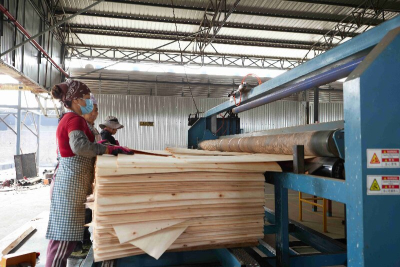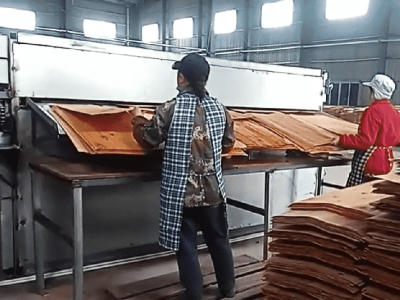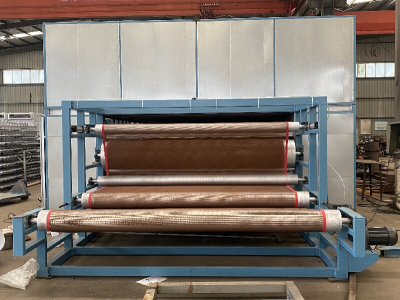Shine Machinery Revolutionizes Wood Processing with Next-Generation High-Capacity Mesh-Belt Veneer Dryer
SHANDONG, China – In the heart of the global wood processing industry, a significant leap forward in drying technology is taking shape. Shine Machinery, a renowned leader in the design and manufacture of industrial drying equipment, has officially launched its flagship Mesh-Belt Veneer Dryer, a machine poised to set new benchmarks for efficiency, capacity, and quality in the production of wood veneer. This state-of-the-art dryer is engineered specifically to meet the soaring demands of modern mills, offering unprecedented high capacity output without compromising on the precise moisture control essential for premium veneer products.
The drying phase is arguably the most critical and energy-intensive stage in wood veneer production. Imperfect drying can lead to a host of issues: discoloration, brittleness, warping, and internal stresses that degrade the value and usability of the final product. Traditional drying methods often struggle with consistency, creating bottlenecks that limit overall production throughput. Recognizing these challenges, Shine’s engineering team embarked on a mission to develop a solution that would not only overcome these hurdles but also redefine industry standards.
The Mesh-Belt Conveyance System: Heart of the Operation
The defining feature of this new dryer is its continuous mesh-belt conveyance system. Unlike static or batch-type dryers, the mesh-belt system allows for a seamless, uninterrupted flow of veneer sheets from the infeed to the outfeed. This continuous process is the fundamental driver behind its high capacity.
The woven-wire mesh belt is itself a marvel of engineering. Constructed from high-temperature resistant stainless steel, it is designed for durability and minimal thermal expansion. Its open structure is crucial, allowing for optimal hot air permeability. As freshly peeled, moisture-laden veneer sheets are automatically fed onto the belt, they are transported through a series of precisely controlled temperature zones within the elongated drying chamber.
This method offers distinct advantages over batch drying:
Consistent Throughput: There is no downtime for loading and unloading batches. Veneer enters and exits the dryer continuously, maximizing machine uptime and aligning perfectly with automated peeling and pressing lines.
Uniform Drying: Each sheet experiences an identical drying journey through the zones, eliminating the variability often seen between batches in a traditional dryer.
Reduced Handling: The automated conveyance minimizes manual handling, reducing the risk of damage to delicate veneers and lowering labor costs.
Engineering Excellence: Precision Heat and Airflow Management
A high-capacity dryer is useless if it cannot dry veneer evenly and gently. The Shine Mesh-Belt Veneer Dryer incorporates a sophisticated multi-zone heating and airflow system that is the true brain of the operation.
The dryer is partitioned into multiple independent sections—typically pre-heating, main drying, and conditioning zones. Each zone features its own independently controlled heating units (often a combination of efficient thermal oil heaters, steam heat exchangers, or advanced electric heating) and a powerful, strategically arranged fan system.
Pre-Heating Zone: The veneer enters this initial zone, where circulated air at a controlled temperature begins to gently warm the wood. This gradual heating prevents case-hardening—a phenomenon where the outer surface dries and seals too quickly, trapping moisture inside and causing defects later.
Main Drying Zone: This is where the majority of moisture removal occurs. High-velocity, turbulent air is forced vertically through the layer of veneer and the mesh-belt. This "through-air" drying technique is exceptionally efficient as it ensures that hot air makes direct contact with every fiber of both sides of the veneer sheet, driving out moisture uniformly. The temperature and air velocity in this zone are meticulously calibrated to the specific species and initial moisture content of the wood veneer.
Conditioning Zone (Tempering): In the final stage, the temperature is slightly moderated to allow for a stress-relief process. This ensures the moisture content within each sheet is equilibrated, and any residual stresses from rapid drying are alleviated. The result is a flat, stable, and perfectly dried veneer sheet exiting the machine, ready for clipping, sorting, and gluing.
The High-Capacity Advantage: Meeting Modern Market Demands
The term high capacity in the context of Shine's dryer encompasses more than just speed. It represents a holistic approach to productivity:
Physical Throughput: These dryers are capable of processing immense volumes of veneer. Depending on the model and the species, capacities can range from dozens to over a hundred cubic meters of veneer per shift. The width of the mesh-belt can be customized to accommodate various veneer dimensions, making it suitable for everything from small decorative veneers to large panels for plywood core stock.
Energy Efficiency: High-capacity drying cannot be economically viable if energy costs are prohibitive. Shine’s dryer integrates several energy-saving features. Advanced heat recovery systems capture waste heat from the humid exhaust air and use it to pre-heat incoming fresh air, significantly reducing the thermal energy required. Well-sealed chambers and high-efficiency insulation ensure minimal heat loss.
Labor Efficiency: The fully automated nature of the conveyor system means one operator can typically manage the entire drying process from a central control panel, a drastic reduction in manpower compared to manual batch systems.
Tailored for the Product: Versatility Across Wood Veneer Types
The flexibility of the Mesh-Belt Veneer Dryer is one of its strongest selling points. The drying parameters—temperature, belt speed, and airflow—can be finely tuned to suit a vast array of wood veneer species, each with its own unique drying characteristics.
Dense Hardwoods (Oak, Maple): Require longer residence times and carefully ramped temperatures to avoid cracking.
Delicate Veneers (Walnut, Cherry): Need gentler heat to preserve their rich color and prevent surface checking.
Rapid-Growth Species (Poplar, Eucalyptus): Can be dried at higher speeds, benefiting tremendously from the continuous high-capacity throughput.
This versatility makes the dryer an ideal investment for mills processing a diverse range of products, from high-value architectural veneers to commodity-grade sheets for plywood manufacturing.
Smart Control: The Intelligent Brain
Operational simplicity belies the technological complexity within. The dryer is managed by a centralized PLC (Programmable Logic Controller) system with a user-friendly touchscreen HMI (Human-Machine Interface). Operators can select pre-set recipes for different wood species or create custom drying programs. Sensors continuously monitor temperature, humidity, and belt speed, making micro-adjustments in real-time to maintain perfect conditions. Remote connectivity options also allow for off-site monitoring and troubleshooting by Sheng Huai’s technical support team, minimizing potential downtime.
Conclusion: Setting a New Standard for the Industry
Shine Machinery's Mesh-Belt Veneer Dryer is more than just a piece of industrial equipment; it is a comprehensive solution for the modern wood veneer producer. By masterfully combining the continuous efficiency of a mesh-belt conveyor with precision thermal dynamics and intelligent control, it delivers genuine high-capacity production that is both economical and superior in quality.
For mills looking to expand their output, reduce their energy footprint, and enhance the consistency of their finished product, this dryer represents the unequivocal future of veneer processing. It is a testament to Shine’s commitment to innovation and its deep understanding of the challenges facing the global wood industry today. As demand for wood-based products continues to grow, technologies like this will be pivotal in ensuring the industry can meet that demand efficiently and sustainably.






